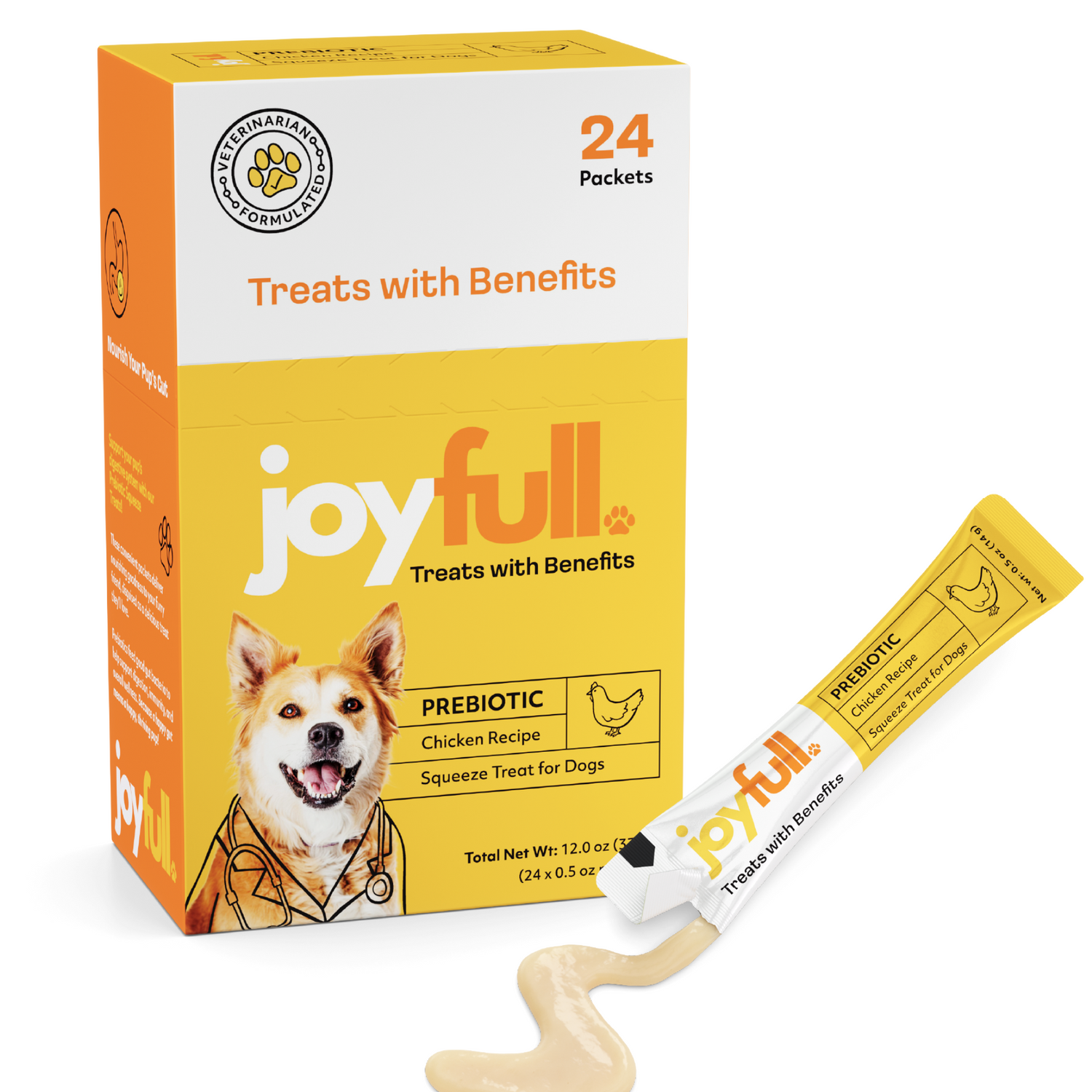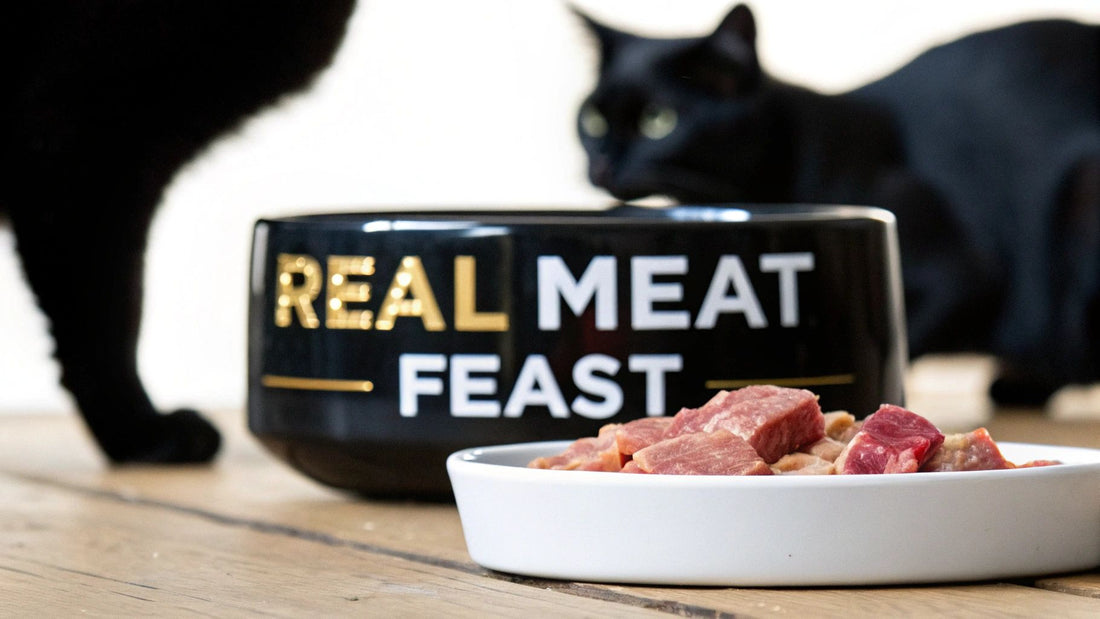
The Truth About Cat Food With Real Meat
When you choose a cat food with real meat, you're doing more than just picking a "premium" option. You're giving your cat a highly digestible, biologically appropriate protein source that aligns perfectly with their natural needs. It’s a decision that respects their very nature as a strict carnivore.
Why Real Meat Is a Game Changer for Your Cat
To really get why real meat is so crucial, you have to look at how cats are built. Unlike dogs or humans who can get nutrients from all sorts of places (plants and animals), cats are obligate carnivores. This is a scientific way of saying their bodies are specifically designed to run on a diet made almost entirely of animal tissue.
Think of it this way: you wouldn't fill up a high-performance sports car with cheap, low-octane fuel and expect it to win any races. A cat’s digestive system is just as specialized. It’s fine-tuned to pull nutrients from animal sources with incredible efficiency. This whole idea boils down to a concept called bioavailability.
Understanding Bioavailability
So, what is bioavailability? It's simply a measure of how well your cat's body can actually absorb and use the nutrients in its food.
Imagine you're trying to get more Vitamin C. You could take a synthetic pill, or you could eat a fresh orange. Your body easily recognizes the vitamin in the orange because it comes in a natural, complete package. It's the same principle for your cat and real meat.
Real meat delivers protein and essential amino acids in their most natural, easy-to-use form. Lower-quality ingredients, like certain plant proteins or heavily processed by-products, just aren't as bioavailable. Sure, your cat can eat them, but their system has to work overtime to get any real value, and a lot of it just ends up as waste.
A diet built around cat food with real meat supports everything from strong muscles and healthy organs to consistent energy. This isn’t a fleeting trend—it’s about feeding them the way nature intended.
The Growing Demand for Quality
This move towards biologically appropriate diets isn't happening in a vacuum; it's a global shift in how we think about our pets. As cat owners learn more, they're demanding better for their furry family members.
The numbers back this up. The global cat food market is expected to jump from USD 66.6 billion in 2025 to USD 91.3 billion by 2035. A huge driver of that growth is the demand for premium foods that feature real, high-quality meat. This reflects a bigger trend of "pet humanization," where we want our pets to eat just as well as we do, with a focus on whole, quality ingredients. You can explore more insights into the cat food market's growth on futuremarketinsights.com.
How to Decode Cat Food Labels Like a Pro
Walking down the pet food aisle can feel overwhelming, can't it? The shelves are packed with brightly colored bags, all making bold claims. It’s hard to cut through the noise and figure out what’s actually good for your cat.
The secret to finding genuine cat food with real meat is learning how to read the ingredient list. By law, this list tells a very specific story about what’s inside that bag.
Think of it like a recipe. The ingredients are always listed by weight, starting with the heaviest. This means the first one to three items are the real stars of the show, making up the bulk of the food. If you see specific, named meats like “deboned chicken,” “turkey,” or “salmon” right at the top, you’re on the right track. That’s a fantastic sign of a high-quality protein source.
This visual decision tree makes it simple to see the choice between providing real meat and settling for less identifiable ingredients—and the impact it can have on your cat's health.
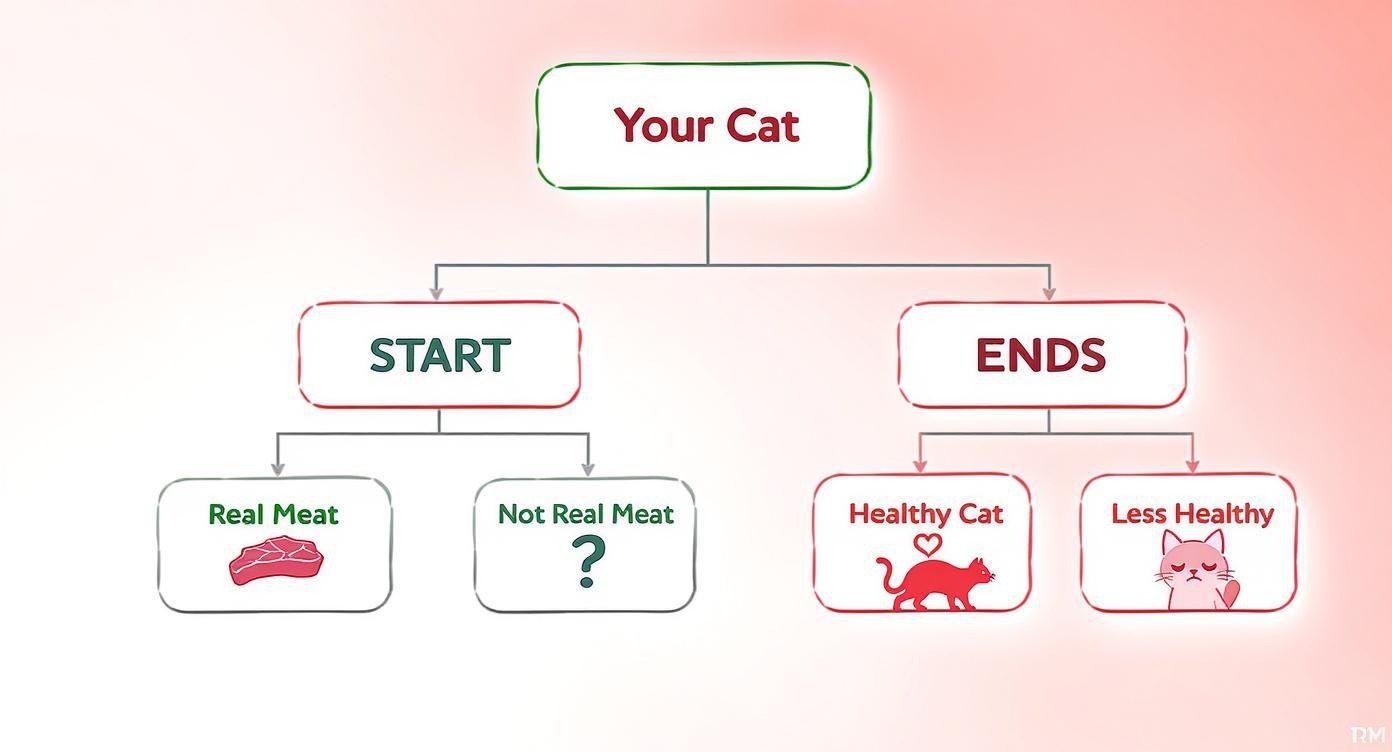
As you can see, the path to a healthier, happier cat really does start with making sure real, identifiable meat is the foundation of their diet.
Spotting Quality Ingredients
The specific language on the label is your best clue. Vague, generic terms are often red flags. For instance, “meat by-products” is a catch-all term that can include a wide range of animal parts, many of which are less digestible and offer inconsistent nutritional value.
Similarly, mystery phrases like “meat meal” or “poultry meal” don't tell you which animal the protein even came from. While a high-quality, named meal (like “chicken meal”) can be a great concentrated source of protein, those non-specific terms should always make you pause. What you're looking for is clarity and transparency.
The most important takeaway is this: look for a whole, named protein source as the number one ingredient. This simple check is the fastest way to gauge the quality of a cat food.
For a more detailed look at making the best dietary choices for your furry family member, our complete guide on how to choose cat food is a great next step.
Comparing High vs. Lower Quality Labels
Let's put this into practice. The table below helps you quickly see the difference between a food built around real meat and one that relies on cheap fillers and vague protein sources.
Spotting Quality on the Ingredient List
| High-Quality Ingredient (What to Look For) | Lower-Quality Ingredient (What to Be Cautious Of) | Why It Matters for Your Cat |
|---|---|---|
| Deboned Chicken, Salmon, Beef | Meat By-Products, Poultry Meal | A named meat is a high-quality, bioavailable protein. Vague terms can hide less nutritious, harder-to-digest ingredients. |
| Chicken Meal | Corn Gluten Meal | A specific "chicken meal" is a concentrated protein. Corn is a common filler and a less effective protein source for carnivores. |
| Sweet Potatoes, Peas | Wheat Flour, Soy Hulls | These are often used as carbohydrate sources. Whole foods offer more nutrients than processed fillers like flour or hulls. |
Once you learn to spot these key differences, you can cut right through the marketing fluff. You'll be able to confidently scan any label and know whether you're holding a bag that truly puts your cat's health first with real, high-quality meat. It's a skill that empowers you to make the best possible choice, every single time.
What Makes Real Meat a Nutritional Powerhouse?
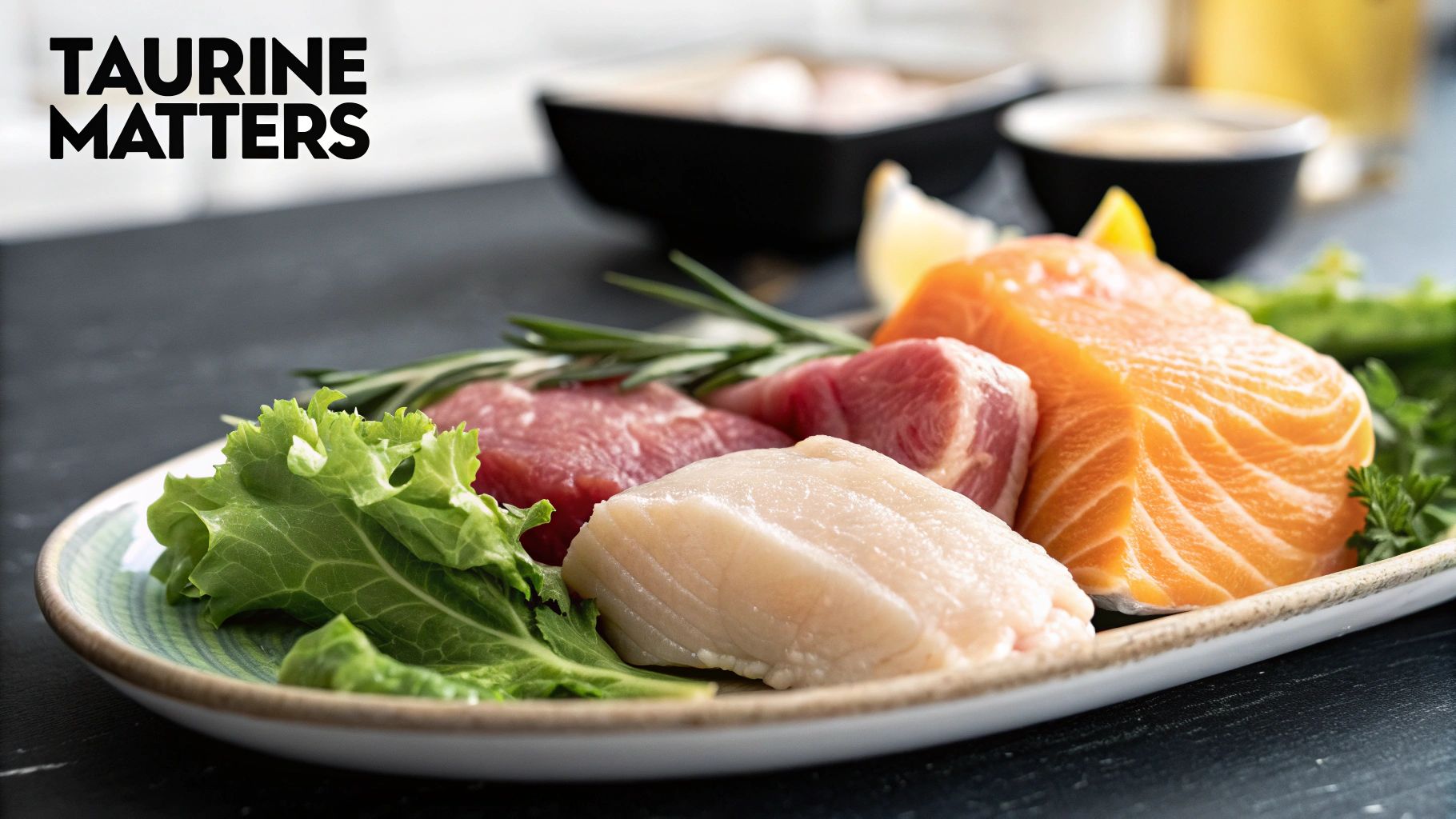
We hear the word "protein" a lot, but it's easy to forget that not all protein is the same—especially when it comes to your cat. Real animal meat isn't just about hitting a high protein number on the bag. It delivers a full suite of essential building blocks, called amino acids, that your cat's body is specifically designed to use.
Think of it this way: you can build a house with perfectly formed bricks or with a pile of mismatched stones. Both are "building materials," but only one creates a strong, stable structure. Real meat provides the perfectly interlocking bricks.
One of the most critical "bricks" is taurine. It’s an essential amino acid that cats can't produce on their own in any meaningful amount. It has to come from their diet, and the best natural sources are animal muscle tissue, heart, and liver. For a cat, getting enough taurine isn't just a good idea—it's absolutely non-negotiable for their survival.
The A-Team: Essential Amino Acids
Amino acids are like a specialized crew of workers, each with a crucial job to do. Real meat brings the entire team your cat needs to stay healthy.
- Taurine: This is the MVP, responsible for everything from heart muscle function and sharp vision to healthy digestion and a robust immune system. A shortage can lead to serious, often irreversible health problems.
- Arginine: Another vital worker that cats must get from food. It’s essential for removing toxic ammonia from their system. Without it, even a single meal high in protein could be dangerous.
Plant-based proteins from ingredients like corn or soy just don't have this complete workforce. A diet built on plant proteins is like a construction site missing its key specialists—the project will be shaky and incomplete.
Choosing cat food with real meat is the most direct and natural way to ensure your cat gets these vital nutrients. It’s how you fuel their body with the compounds they are biologically wired to need for a long, healthy life.
The Big Picture: Why Animal Protein Wins
It’s not just about one or two amino acids, though. Real meat offers a whole spectrum of vitamins and fatty acids that are tough to replicate effectively with synthetic additives. Take Vitamin A, for instance. Humans can convert it from beta-carotene in plants (like carrots), but cats can't. They need the pre-formed Vitamin A found naturally in animal tissues.
This complete nutritional package is what makes a diet centered on high-quality animal protein so powerful. It’s not just one ingredient doing the work; it's about how all the nutrients in real meat function together seamlessly.
To dive deeper into this topic, check out our article on the benefits of cat food with high protein. This nutritional foundation is what supports everything from their silky coat and healthy skin to the playful energy we all love to see.
Choosing the Right Type of Real Meat Cat Food
https://www.youtube.com/embed/jLNiAxeNlXQ
Okay, so you're on board with feeding your cat a food that's built around real meat. That's a huge step in the right direction! But now you're standing in the pet food aisle (or scrolling online), and the options can feel a little overwhelming.
You've got wet food, dry food, freeze-dried options... what's the difference? It's not just about what your cat finds tastiest. The best choice really comes down to a mix of your cat’s specific health needs and what works for your daily routine. Let's break down what each type brings to the table.
Wet Food: The Hydration Hero
For many feline nutrition experts, wet food is the top choice, especially when we're talking about getting high-quality animal protein into a cat's diet. It just closely mimics what they would eat in the wild.
The biggest win here is moisture. Cats are notoriously bad at drinking enough water because their ancestors got most of it directly from their prey. This extra hydration in wet food is fantastic for supporting kidney and urinary tract health—two very common trouble spots for our feline friends. Plus, the rich smell and soft texture are often a lifesaver for picky eaters.
The market is definitely catching on. While dry food still commands a big chunk of sales at 42.5% market share, the demand for premium, meat-first wet foods is surging. Big brands are finally listening and pouring money into formulas that put real meat where it belongs: right at the top of the ingredient list. You can see just how much the industry is shifting by checking out these global pet food market trends.
Dry Food: The Convenient Classic
There's no denying it: kibble is easy. It has a long shelf life, it's a breeze to measure out, and it works perfectly if you prefer to "free-feed" your cat throughout the day. For sheer convenience, dry food is tough to beat.
Kibble used to get a bad rap for being full of carbs and low on quality meat, and frankly, a lot of it deserved it. But things are changing. Modern, high-quality dry foods are using better manufacturing methods to pack in more fresh and dehydrated meats, giving cats a protein-rich meal with that crunchy texture many of them love.
The rule of thumb is simple: if you're going with dry cat food with real meat, flip the bag over. A named animal protein source must be the first ingredient. No exceptions. To get a better handle on the pros and cons, our detailed guide on wet vs. dry cat food is a great place to start.
Key Takeaway: Both wet and dry foods can be excellent choices, as long as they are formulated around high-quality, real animal protein. The best decision is often about balancing your cat's need for hydration with your own lifestyle and budget.
Freeze-Dried and Raw: The Ultimate in Nutrition
For cat owners who want to get as close as possible to a cat's natural, ancestral diet, freeze-dried and raw foods are the pinnacle.
-
Freeze-Dried Food: Think of this as the best of both worlds. You get all the nutritional power of raw meat, but with the convenience and shelf-life of kibble. The freeze-drying process gently removes moisture, locking in all the important nutrients and enzymes. Just add a little water, and you have a powerhouse meal ready to go.
-
Raw Food: This is the real deal—a diet of uncooked meat, organs, and sometimes bone. Advocates of raw feeding will tell you the benefits are undeniable: better digestion, shinier coats, and more energy, all because the nutrients are in their most natural and bioavailable state.
Of course, these options require careful handling to keep things safe. But for those willing to put in the effort, they offer a level of pure, unprocessed nutrition that's second to none.
A Simple Plan for Switching Your Cat's Food
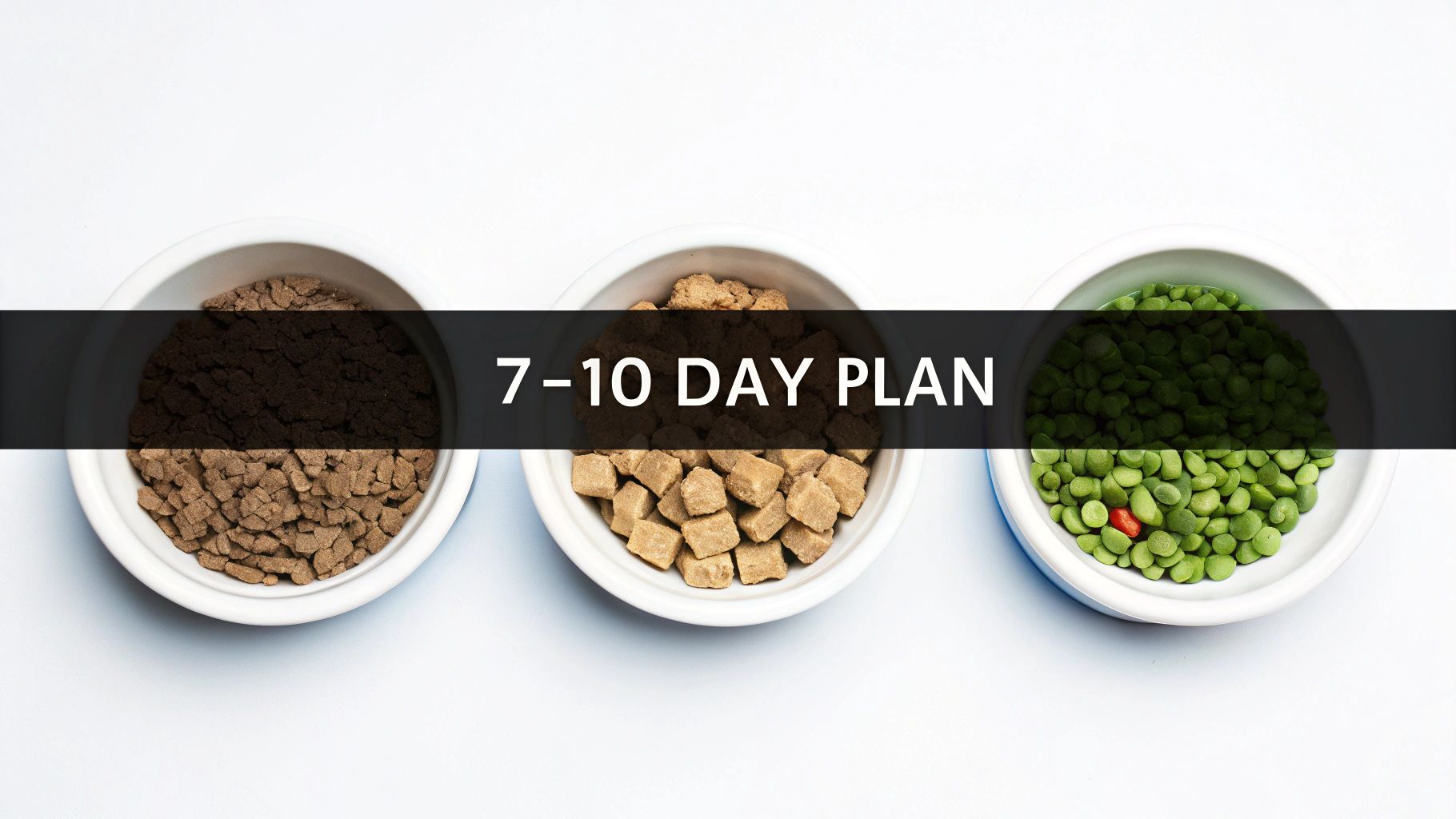
Deciding to upgrade your cat to a high-quality, cat food with real meat is a fantastic move for their long-term health. But if you've ever tried to swap their food overnight, you know it can backfire. Cats have notoriously sensitive digestive systems, and a sudden change is the fastest way to cause an upset stomach.
The secret to a successful switch is patience. Think of it like introducing a toddler to new vegetables—you wouldn’t serve them a giant plate of broccoli and expect a warm welcome. The best approach is a slow and steady transition over 7 to 10 days, giving their gut plenty of time to get used to the new ingredients.
The 7-Day Transition Schedule
This simple, proven schedule is your roadmap to a seamless food swap. The idea is to gradually increase the amount of new food while phasing out the old stuff, letting your cat’s palate and digestive enzymes adapt without any stress.
Here’s a breakdown of the daily mix:
- Days 1-2: Start with a mix of 75% old food and just 25% new food.
- Days 3-4: Move to an even 50/50 split of old and new food.
- Days 5-6: Tip the scales to 25% old food and 75% new food.
- Day 7: Congratulations, you're on 100% new food!
If you know your cat is especially fussy or has a delicate stomach, don't be afraid to stretch this out over 10 days or even two weeks. The key is to watch your cat and adjust the pace based on how they're handling it.
Remember: Patience is your greatest tool. A slow transition is far more effective than a rushed one, ensuring your cat fully accepts and thrives on their new, healthier diet.
Watching for Positive Changes
Once the transition is complete, the fun part begins: watching the benefits roll in. A diet built around real, high-quality meat can make a visible difference in your cat’s overall well-being.
Keep an eye out for these positive signs:
- Improved Digestion: One of the first things you'll likely notice is a change in the litter box. Smaller, firmer, and less smelly stools are a great sign that their body is absorbing more nutrients from their food.
- Increased Energy: Better fuel means better performance. You might just find your cat has more pep in their step, engaging in more play and showing more interest in their surroundings.
- Healthier Skin and Coat: The high-quality proteins and essential fatty acids found in real meat are wonders for a cat's appearance. Look for a shinier, softer coat and a reduction in skin issues like dandruff or itchiness.
If you hit a snag and your cat turns their nose up at the new food, don't give up. Try warming the new food just a tiny bit to make it more fragrant, or mix a little warm water into their wet food to create a gravy. Sometimes, a simple trick is all it takes to win them over.
Answering Your Questions About Real Meat Cat Food
It’s totally normal to have a few questions, even after you’ve seen all the great reasons to switch your cat to a better diet. Making the move to a cat food with real meat is a big deal, and you want to be sure you're making the right call. Let's tackle some of the most common concerns we hear from cat parents.
Think of this as your go-to FAQ. We’ll give you clear, straight-up answers to help you sort through the final details, so you can feel confident and ready to move forward.
Is Cat Food With Real Meat More Expensive?
This is usually the first thing people ask, and let's be honest: yes, it often is. A food that lists deboned chicken or whole salmon as its first ingredient is naturally going to cost more than one packed with cheap fillers like corn, wheat, or mystery "meat by-products."
But it helps to reframe this as an investment in your cat’s health, not just an expense. When the food is more nutrient-dense, your cat's body actually uses more of it. That can mean smaller portion sizes and less waste in the litter box. More importantly, a proper diet is the foundation for long-term wellness, potentially saving you from hefty vet bills for things like digestive upset or skin issues down the line.
Are "Meat Meals" a Bad Thing to See on the Label?
The word "meal" on an ingredient list can definitely be confusing, but it's not automatically a bad sign. A meat meal is just meat that has gone through a process called rendering, where the water and fat are cooked out. What’s left is a highly concentrated protein powder.
The real trick is to look for specifics. A named source like "chicken meal" or "salmon meal" is a great, high-quality protein source. Where you need to be cautious is with vague, generic terms like "meat and bone meal" or "poultry meal." If they don't tell you which animal it came from, you can't be sure of the quality or consistency.
The Bottom Line: A named meal (like "turkey meal") is a quality ingredient. An unnamed meal (like "meat meal") is a red flag. It’s better to find a brand that’s more transparent.
This push for transparency is really changing the pet food world. Even with the convenience of online shopping, a massive 94.6% of pet food sales still happen in brick-and-mortar stores. Why? Because people want to physically pick up the bag, flip it over, and read the ingredient list for themselves—a simple act that holds brands accountable.
Should I Go With a Grain-Free Food?
Grain-free diets have become a huge topic, but they aren't the magic bullet for every cat. If your cat has a true grain allergy, switching to a grain-free food can be a game-changer. But in reality, diagnosed grain allergies in cats are pretty rare. It's much more common for them to have sensitivities to a specific protein, like chicken or fish.
For the average healthy cat, high-quality whole grains like brown rice or oats are perfectly fine. The most important thing to focus on will always be the first few ingredients on the list. A food that starts with real meat is a far better choice than a grain-free one that leads with starches like potatoes and pea protein. Always put high-quality animal protein first.
Of course, when you start thinking about your cat's main diet, it often brings up questions about other foods, too. If you're curious about which human foods are safe, you can start by learning more about things like, Can cats eat watermelon?.
At Joyfull, we believe that giving your pet the best shouldn't be complicated. Our formulas are made with clean, high-quality proteins and are reviewed by our in-house veterinary advisor to ensure your cat gets nothing but the good stuff. Explore our commitment to no-BS pet wellness at https://joyfullpet.com.
